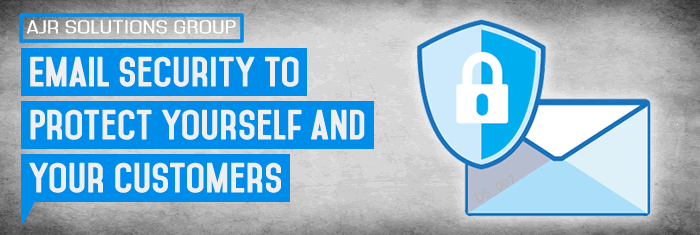In this article AJR will discuss Email Security to Protect Yourself and Your Customers
When it comes to interacting with customers, email is among the easiest and most widely used forms of communication; it’s simple, convenient, and cost-effective. But there’s one thing it’s not: 100% secure. If you are not taking the correct proactive steps to secure your email, then you’re exposing yourself — and your customers — to unnecessary risks.
Email security isn’t complicated, but it does require your organisation to put forth a strategic and concerted effort. Postulating that security will take care of itself is foolish and unrealistic. Here are some email security tips for protecting yourself and your customers.
Stop being lazy with passwords
There’s no longer an excuse for lazy password habits. The importance of password integrity has been heavily discussed over the past couple of years and there’s no excuse for not being proactive on this front. Not only should passwords be unique and complex, but they also need to be changed frequently (at least every couple of months). It’s also a good idea to require two-factor authentication any time you access your email from a new device or network.
Spend on encryption
Few things matter more than encryption. While you may email a particular file to one person, there’s nothing stopping that person from sharing the file with other people who shouldn’t have access to it. The best solution is to invest in client-side encryption.
With client-side encryption – such as this service offered by Virtru – you can encrypt emails before they leave your device to carefully prevent third-party access. You also gain administrative access and control over attachments and files, which lets you see where data is travelling and gives you the ability to revoke access at any point along the way. This may seem like more control than you need, but as they say, it’s better to be safe than sorry.
Be wary of attachments.
Hackers use a number of different avenues and methods for infiltrating a business and collecting data, but email is a preferred channel. And some of their most dangerous methods are the most simple. They’ll send phishing links or malware attachments and ask the recipient to click.
While you’d like to assume your employees are savvy enough to spot these scams, not all of them are. A recent survey found that 51 percent of companies had malware squeak past their email filters in the previous 18 months. Exactly half of companies surveyed had employees click on phishing links over that same period. Roughly 55 percent of respondents say they’re not certain that their employees won’t click on malicious email attachments or phishing links.
One of the best things you can do is educate your employees on email security best practices – particularly when it comes to inbound emails and clickable links or attachments.
Be careful with confidential information
There’s certain confidential information that should never be sent via email – even if a customer requests it. Stuff like bank account numbers, social security numbers, passwords, and other secure data should instead be faxed, mailed, or discussed over the phone. Email encryption will help prevent this information from getting into the wrong hands, but it isn’t always a foolproof strategy. Sometimes it’s best to just avoid sharing confidential information over email altogether.
Show customers you care
The quickest way to lose trust is by leaking a customer’s private information. It doesn’t really matter if it’s blatant or inadvertent. The fact that you can’t safeguard their information speaks to your inadequacy and lack of integrity (at least in their eyes). If you want to show your customers how valuable they are to your company, start by taking security – and email security, in particular – seriously.


